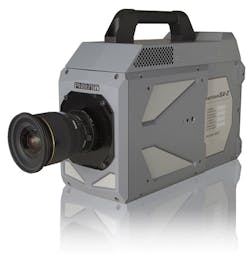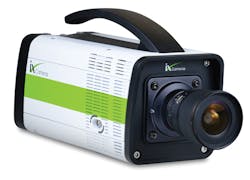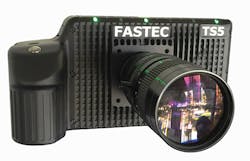Applying high-speed imaging in vision applications
Multiple options exist for those wishing to deploy high-speed cameras.
With the advent of lower-cost CMOS imagers, high-speed cameras are becoming more commonplace. These cameras are now being increasingly used in numerous applications that include scientific, motion analysis and automotive crash test applications.
Before deciding on which type of high-speed camera is best suited for a particular application, however, specifications such as frame rate, resolution, storage capability and the type of camera to computer interface must carefully be considered. Just as importantly are the types of lenses the camera can support and what type of lighting must be used to generate the highest contrast images.
Shutter speed
Since applications for high-speed imaging are highly specific, balancing these technical factors will allow the most cost-effective camera to be chosen. Two of the most important considerations are the minimum shutter speed and maximum frame rate of camera.
While the shutter speed is the time taken to expose an individual image, the maximum exposure time can never be greater than 1/frame rate. Using a shutter speed of 1/1000th of a second does not relate to a frame rate of 1,000 fps, since the frame rate of the camera could be set to a slower rate (e.g. 30fps) with each frame being exposed for 1/1000th of a second (see "Frame rate vs. shutter speed;" www.bit.ly/1NFwfz0).
Thus, using an exposure time of 1/1000th second and a frame rate of 30fps as opposed to an exposure time of 1/500th second at the same 30fps frame rate will result in images that are sharper since each frame will be exposed for a shorter amount of time and motion blur will be minimized. However, in both cases, an object moving across the field of view of the camera will cover the same amount of distance between each successive frame.
One of the effects of using fast exposure times is that the amount of light required to illuminate the subject being imaged may need to be increased.
"For any given amount of desired "contrast" in the image, the amount of light will need to be doubled if the exposure time is halved, regardless of the sensitivity of the sensor. In other words, to have equal results, you must double the light if you halve the exposure. You need the same number of photons striking the sensor in half the time to get an equally "lit" image," says Rick Robinson, Vice President of Marketing at Vision Research (Wayne, NJ, USA; www.highspeedcameras.com).
While using a fast lens - that is, one with a larger maximum aperture (and therefore a smaller minimum f# number) can capture more light, the sensitivity of the detector used in high-speed cameras is an equally important factor to consider, since as sensitivity increases, the exposure time can be decreased.
ISO Standards
Some high-speed camera manufacturers use the International Organization for Standardization (ISO) standard to specify this sensitivity. While ISO Standard 12232 defines three ways to measure ISO sensitivity, the most commonly used relates sensitivity to the exposure necessary to saturate the camera system. This ISO value can then be used to determine the nominal exposure time of the camera and/or the lighting requirements. A mathematical description of how this value is derived can be found on the website of DxO (San Francisco, CA; USA; www.dxo.com) at www.bit.ly/1MMKUnN while other websites explain the relationship between aperture, shutter speed and the ISO standard (see "Camera sensitivity - useful articles on the web," p. 31 this issue).
Companies such as Imatest (Boulder, CO, USA; www.imatest.com) use this Saturation-based ISO Sensitivity (Ssat) standard to measure the sensitivity relative to the luminance level that saturates the sensor or camera system. Such values are used by companies such as Photron (San Diego, CA, USA; www.photron.com) in its FASTCAM SA-Z (Figure 1), a 12-bit 1024x1024 high-speed camera that runs at 20,000 fps and features an ISO sensitivity of ISO 50,000 (monochrome) ISO 20,000 (color). For its part, Vision Research offers the Phantom v1612 which has a monochrome daylight sensitivity of ISO 32,000.
"Some manufacturers list their ISO light sensitivities with both "T", for Tungsten, where the IR filter is removed to establish a higher value, and a lower "D" for daylight value that is achieved using the published ISO 12232 Ssat standard," says Andrew Bridges, Director of Sales and Marketing at Photron. "By removing the IR filter, more photons can be converted to a signal, boosting quoted ISO "T" values to levels users can never hope to achieve."
In such cameras, the use of a color filter array (CFA) on the image sensor will reduce the amount of light captured at each photo-site, thus lower the ISO rating. However, while the ISO standard can be used to determine the sensitivity of a camera, it is unrelated to image quality since increasing camera gain can be used to increase the ISO speed at the cost of adding noise to the image.
Increasing sensitivity
To increase the sensitivity of their high-speed cameras many manufacturers use imagers with high quantum efficiency and fill factors. For this reason, many high-speed camera manufacturers use imagers with large pixel sizes. In the design of its i-Speed 726 camera for example, iX cameras (Rochford, Essex, England, UK) www.ix-cameras.com) uses a custom CMOS 2048 x 1536 pixel imager with square pixel sizes of 13.5μm (Figure 2) Capable of running at 8,250 fps speeds at full resolution, the camera is specified with a maximum ISO sensitivity of 40,000 (monochrome) and 14,400 (color).
While increased pixel sizes can increase the sensitivity of the camera, they have the opposite effect on the resolution of captured images since resolution measured as line-pairs/mm that can be resolved with larger pixels will be less than that of smaller ones. In many high-speed applications, however, this may be less of an important consideration.
Frame rates
While sensitivity is an important parameter to be considered when specifying a high-speed camera, so too is the frame rate of the camera. To increase the frame rate, manufacturers of cameras that incorporate CCD or CMOS use different techniques. With CCD cameras, a technique known as partial scanning is used to read a variable band from central part of the imager, reducing the need to output a charge from each pixel of the CCD and thus increasing the frame rate.
By using CMOS imagers in their designs, both the width and height of this region of interest (ROI) can vary, increasing the flexibility of frame rates rates that can be obtained. In the design of its Q-MIZE HD v2 camera, for example, AOS Technologies (Baden Daettwil, Switzerland; www.aostechnologies.com) uses a 1920 x 1080 CMOS imager that can be operated in a number of different formats. While a 1,000fps rate can be achieved at 1920 x 1080, running the camera in 1024 x 1024, 1280 x 720, 853 x 480 modes results in frame rates of 2,000, 2500 and 5,000fps respectively.
Capturing image data
When such frame rates are achieved, the image data must either be captured on-camera or transferred to a host computer using a high-speed interface. In applications that require the camera to be portable and untethered, the camera must capture sequences of images for relatively long periods of time. In high-speed applications, this "long period of time", however may be only a matter of seconds since the camera may be triggered to capture an event at a given point in time.
For other applications, it may be possible to capture image data on the camera for longer periods of time. A portable high-speed camera, such as the TS5-D from Fastec Imaging (San Diego, CA, USA; www.fastecimaging.com), for example, uses a 2560 x 2048 CMOS imager to capture full HD images at a rate of 634fps to 8GBytes of memory (Figure 3). To store these images onboard at data rates of approximately 20GBytes/min, the camera features an internal solid-state drive with up to 1TByte capacity. Alternatively, the camera may stream images directly to the SSD (720p at 510fps) for about 35mins. The camera's Gigabit Ethernet port then allows image sequences to be transferred to a host computer at rates up to 90MB/s for later analysis.
Like Fastec Imaging, Mikrotron (Unterschleißheim, Germany; www.mikrotron.de) also offers a number of both portable and tethered cameras. Taking advantage of the CoaXPress (CXP) interface, the company's EoSens 4CXP camera allows images of 2336 x 1728 pixels to be captured at more than 2,000fps (in reduced 640 x 480 ROI mode) and transferred to a host computer at speeds of up to 25Gbit/s over 100m distances.
Since 2006, Vision Research has offered its CineMag interface allowing for on-camera storage at rates of 1Gpixel/s. One megapixel images can then be captured at 1,000 fps and then transferred over a 10Gbit/s Ethernet interface for subsequent download to a computer.
Today, high-speed cameras are being used in numerous scientific, industrial, aerospace and automotive applications (see "High-speed cameras address disparate applications," p. 29 this issue). While, many high-speed camera vendors use custom-built multi-tap CMOS imagers in their designs to address these applications, the advent of off-the-shelf imagers capable of increasingly faster data rates has allowed lower-cost high-speed cameras to be introduced.
While these may not yet exhibit the performance of those developed using custom-built devices, the low-cost of cameras developed using off-the-shelf devices will lower the cost of high-speed imaging, enabling a larger number of systems integrators to deploy them.
High-speed cameras address disparate applications
High-speed cameras for turbulent combustion studies
Increased thrust performance and fuel efficiency are some of the main challenges for high-speed propulsion engines. Dr. Kareem Ahmed at the University of Central Florida (Orlando, FL, USA; www.ucf.edu) is using FASTCAM SA-Z cameras from Photron (San Diego, CA, USA; www.photron.com) in turbulent combustion studies to improve propulsion performance. www.bit.ly/1VRUZHl
X-ray systems study vertebrate feeding behavior
Researchers at the University of Chicago's Ross Lab (Chicago, IL, USA; www.rosslab.uchicago.edu) are modeling motor control and biomechanics with a focus on vertebrate feeding behaviors. The X-ray video lab includes ProCapture camera systems from Xcitex (Woburn, MA, USA; www.xcitex.com) to collect 3D X-ray data, 3D visual data and 32 channels of sensor data at the same time. www.bit.ly/1RIurlH
NASA Scientists study 16,000MPH projectiles
To mimic high-speed collision effects of space debris, NASA used four, 2-stage light gas guns to fire projectiles that reach speeds exceeding 16,000 MPH. To record the motion of these projectiles, NASA is using three Phantom v711 cameras from Vision Research (Wayne, NJ, USA; www.highspeedcameras.com).www.bit.ly/22RIWz1
High-speed vision system targets ballistics analysis
Tasked with capturing high-speed images for a ballistics application, odos imaging (Edinburgh, Scotland; www.odos-imaging.com) has developed a coupled camera and illumination system. The company's SE-1000 high-speed recording camera and IL-0900 illumination modules were deployed in an ordnance testing facility to capture images of high-velocity rounds after they exit from a rifle muzzle. www.bit.ly/1YgVYE4
Imaging system assess pavement conditions
To acquire, assess and map roadway pavement conditions, Southeastern Surveying and Mapping Corp (SSMC; Orlando, FL, USA; www.southeasternsurveying.com) worked with NorPix (Montreal, QC, Canada; www.norpix.com) to develop a mobile imaging vehicle equipped with two high-speed imaging cameras logging data to an on-board computer. www.bit.ly/1RPDqrA
Monitoring welding at high-speed
To support research into increasing material safety at the Helmholtz Centre for Materials and Coastal Research (Geesthach, Germany; www.hzg.de), Optronis (Kehl, Germany; www.optronis.com) has combined high-speed cameras with special lighting technology for real-time inspection of weld seams and the welding process. www.bit.ly/1ZNnuGc
Optical measurement techniques optimize wing design
Professor Ganapathisubramani at the University of Southampton (Southampton, England, UK; www.southampton.ac.uk) is using 3D Digital Image Correlation (3D-DIC) to capture the deformation of a wing and Time-Resolved Particle Image Velocimetry (TR-PIV) to measure air flow using an optical measurement system from LaVision (Goettingen, Germany; www.lavision.de).www.bit.ly/1RPFhwA
Companies mentioned
AOS Technologies
Baden Daettwil, Switzerland
www.aostechnologies.com
DxO
San Francisco, CA; USA
www.dxo.com
Fastec Imaging
San Diego, CA, USA
www.fastecimaging.com
Future Publishing
Bath, England, UK
www.digitalcameraworld.com
Helmholtz Centre for Materials and Coastal Research
Geesthach, Germany
www.hzg.de
Imatest
Boulder, CO, USA
www.imatest.com
iX Cameras
Rochford, England, UK
www.ix-cameras.com
JAI
San Jose, CA, USA
www.jai.com
LaVision
Goettingen, Germany
www.lavision.de
Mikrotron
Unterschleißheim, Germany
www.mikrotron.de
NorPix
Montreal, QC, Canada
www.norpix.com
odos imaging
Edinburgh, Scotland
www.odos-imaging.com
Optronis
Kehl, Germany
www.optronis.com
Photron
San Diego, CA, USA
www.photron.com
RED
Irvine, CA, USA
www.red.com
University of Central Florida
Orlando, FL, USA
www.ucf.edu
University of Chicago's Ross Lab
Chicago, IL, USA
www.rosslab.uchicago.edu
University of Southampton
Southampton, England, UK
www.southampton.ac.uk
Vision Research
Wayne, NJ, USA
www.highspeedcameras.com
Xcitex
Woburn, MA, USA
www.xcitex.com
Camera sensitivity - useful articles on the web
Color vs. monochrome image sensors-from RED (Irvine, CA, USA; www.red.com) www.bit.ly/1USTGnJ
What is ISO sensitivity?-from DxO (San Francisco, CA; USA; www.dxo.com) www.bit.ly/1MMKUnN
Boosting Camera Sensitivity - The ISO 12232 Spec - from Vision Research (Wayne, NJ, USA; www.highspeedcameras.com)www.bit.ly/1VRSnsZ
ISO Sensitivity and exposure index - from Imatest (Boulder, CO, USA; www.imatest.com) www.bit.ly/1RplZMh
Camera sensitivity explained - from JAI (San Jose, CA, USA; www.jai.com) www.bit.ly/1pAk6BL
Aperture, shutter speed and ISO explained - from Future Publishing (Bath, England, UK; www.digitalcameraworld.com) www.bit.ly/1Oe7CdR
Boosting Camera Sensitivity - from Vision Research (Wayne, NJ, USA; www.highspeedcameras.com) www.bit.ly/1RJ1Fm1
About the Author

Andy Wilson
Founding Editor
Founding editor of Vision Systems Design. Industry authority and author of thousands of technical articles on image processing, machine vision, and computer science.
B.Sc., Warwick University
Tel: 603-891-9115
Fax: 603-891-9297



